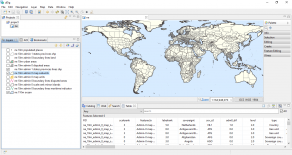

It has a very fl exible plugin-in mechanism to add features and to customize the user interface, but most importantly it is supported by a very solid industrial foundation (the list of Eclipse members can be found at: showAllMembers.php). Its interface is built upon the Eclipse rich client platform, guar- anteeing a native look-and-feel in any of the operating systems. Hence it is capable of using geodata served via standards such as Web Feature Services (WFS), Web Map Services (WMS), Web Coverage Services (WCS), GeoRSS, and KML.
#UDIG DOWNLOAD MAC#
uDig runs as a rich client under different platforms (Windows, Mac OS/X and Linux) it is web- service oriented. Eventhough the uDig project is not a key aspect of this paper it is useful to point out some of its main characteristics. The GIS interface is currently built on uDig 1.3.1 (uDig stands for User friendly Desktop Internet GIS) as shown in Fig. The next three subsections present the JGrass-NewAGE parts in more in detail. However, interoperability with R as external tool was already added to OMS as an experimental feature.

1, on the basis of the same tools developed for research, which is not possible using only the R language. Furthermore, we wanted to maintain the possibility of building entire operational systems, as the one depicted in Fig. uDig inherits the tools for the treatment of geographical entities from the GeoTools Toolkit ( R ( was also considered as an alternative, but discarded since it does not offer enough fl exibility and ef fi ciency for intensive computational Modelling, eventhough it is powerful for post processing of model results, graphics and automatic calibration tools. This ful fi lls the additional requirement of using a completely open-source tool chain for development, which may simplify its adoption by models developers. Eclipse was also chosen as IDE for compiling and developing models. Using uDig as a basis also implied the use of Eclipse as the Rich Client Platform (RCP) for part of the project.


 0 kommentar(er)
0 kommentar(er)
